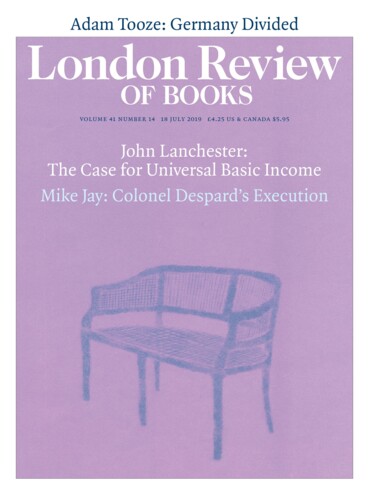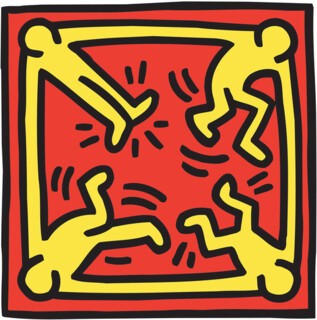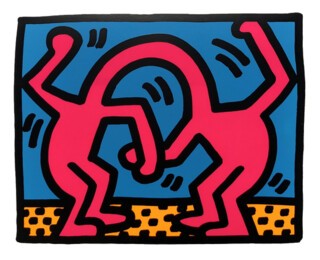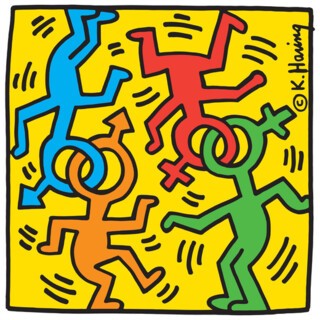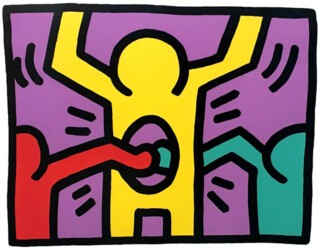A voiceover on the CBS evening news of 20 October 1982 described the American artist Keith Haring: ‘He stalks the New York City subways waiting for his chance to strike. When the opportunity comes he moves fast. He has to.’ We see Haring furtively alight a subway car at Madison Square Garden, take a stick of chalk from the back pocket of his jeans and draw onto a blank advertising space: first a border, like a television set, then a series of cookie-cutter figures, activated by motion lines and embellished with crosses on either side, and, in the top corner, a heart sealed by a circle like a copyright logo. Haring is 24. He’s tall so he stoops slightly. His hand is quick and his line is effortless. When the segment aired, his first solo exhibition had just opened at the Tony Shafrazi Gallery and he was already a darling of the downtown art scene. CBS reported that his work was selling for ‘fancy prices’: $15,000 for a ‘two-hour special’.
Haring was a small-town boy from Kutztown in Pennsylvania, who grew up in a culturally conservative home: ‘I distinctly remember hearing my mother say that the boat that brought over the Beatles should have sunk.’ After graduating from high school he enrolled at the Ivy School, a commercial art college in Pittsburgh, where he began to develop his vocabulary of repeated geometric forms. At home for Christmas, he found a copy of Robert Henri’s The Art Spirit (1923) in a flea market. Henri was the leader of the Ashcan School of artists, who portrayed everyday working-class scenes (his students included Edward Hopper); the book opens with the statement that ‘art when really understood is the province of every human being.’ Haring had only just begun his course, but decided to drop out: ‘If I was going to be an artist, that’s what I was going to be!’
He arrived in New York in 1978 with a scholarship at the School of Visual Arts. Cheap rent had made lower Manhattan attractive for artists, musicians, writers and filmmakers. Three years earlier, President Ford had refused to give the city federal support to save it from bankruptcy; the Daily News headline ran: ‘FORD TO CITY: DROP DEAD.’ Yet, as the downtown writer Glenn O’Brien recalled, ‘instead of dropping dead, New York came alive.’ Experimental venues emerged, dedicated to a new scene of live music, fancy dress, performance and installations. The Mudd Club opened on Halloween 1978 (the name announced its intention to be the antithesis of Studio 54) and Club 57 followed the next year in the basement of the Holy Cross Polish National Church on St Mark’s Place. Haring became a fixture at both, first as a partygoer and then as a performance artist and exhibition organiser.
It was the subway drawings, begun in 1980, that brought Haring to the attention of the art world. The idea was inspired: when the lease on an advert ran out the transit authorities would paste black paper over it, which Haring used as a blank canvas. Chalk cost next to nothing and drew beautifully on the soft black paper – plus the subway brought an immediate audience. He was conscious from the start of the appeal of the project and asked his friend Tseng Kwong Chi (a fellow student at the SVA) to capture him at work. These photographs, mostly shot in black and white, document the performative aspect of the work. We see commuters looking on as Haring energetically decorates the wall with dancing figures, barking dogs, flying spaceships and radiant babies. We also feel the tension between the innocent vitality of his imagery and the illicit nature of the activity (he was repeatedly arrested while drawing), which he continued until 1985, making more than five thousand images.
Haring was one of a number of emerging artists interested in graffiti. In autumn 1979 he wrote a list of his influences on a piece of graph paper: alongside art school idols – Artaud, Wittgenstein, Genet – are the names Samo and Jenny Holzer. Samo was the invention of Jean-Michel Basquiat and his classmate Al Diaz, who together placed cryptic statements in prominent SoHo locations: ‘SAMO© AS A CONGLOMERATE OF DORMANT GENIUS’. Holzer described her ‘truisms’ (‘ABUSE OF POWER COMES AS NO SURPRISE’) as a ‘Reader’s Digest version of Western and Eastern thought’; she would print them on colourful copy paper and fly-post them around the city. All three were included in a number of group exhibitions, notably The Times Square Show of June 1980, held in a former massage parlour and described by the Village Voice as ‘the first radical art show of the 1980s’, and New York/New Wave at PS1 in February 1981, which also featured a number of more ‘traditional’ graffiti artists, including Lady Pink and Futura.
In December 1981, the writer and performer Rene Ricard wrote in Artforum that Haring ‘is so famous now’ that he was ‘mugged by four 13-year-olds for the buttons he was carrying (as well as for his Sony Walkman)’. ‘The Radiant Child on the button is Haring’s Tag,’ Ricard continued. ‘It is a slick Madison Avenue colophon. It looks as if it’s always been there, like a proverb.’ Haring was often dismissed as a ‘club kid’, whose imagery was cute, but was hardly worthy of serious art historical attention. His facility as a draughtsman was precisely what led many critics to consider his work facile: his style was too recognisable, his idiom too successful. Ricard was warning against this false equivalence. The proverb-like quality of Haring’s drawings comes from his engagement with semiotics and hieroglyphs – the way meaning is encoded in sign and image – as well as his sustained study of other artists who worked obsessively with line, from Pierre Alechinsky to Jackson Pollock.
Haring used his growing celebrity to further political causes that were close to his heart. His work is full of references to the dangers of homophobia, fundamentalism, nuclear power, racism. One of his ‘tarp’ paintings – made on cheap, brightly coloured vinyl tarpaulin – features an enormous atom icon, radiating with energetic lines; another shows two figures fighting with crosses. There are light bulbs everywhere, like a call for clarity or inspiration, as well as lots of sexual imagery, reflecting Haring’s belief in the urgent need to celebrate gay love. When the Aids epidemic took hold in the early 1980s (the first death in New York was that of the German performance artist Klaus Nomi), he became closely involved in the campaign to increase public awareness. His painting Silence = Death appropriated the notorious Act Up poster: Haring filled the background with figures covering their eyes, mouths and ears to represent Ronald Reagan’s refusal to acknowledge or respond to the scale of the crisis. It was made in 1989, the year after Haring was diagnosed HIV-positive; he died in 1990, aged 31.
‘I am wondering if the museum world will ever embrace me … or if I will disappear with my generation,’ Haring wrote in a diary entry in 1988. He was included in several important exhibitions during his lifetime, including Documenta in Kassel in 1982 and the Whitney Biennial in 1983, but his only major solo show in a museum was at the Stedelijk in Amsterdam in 1986. This institutional ambivalence was no doubt influenced by the market success of his work as well as by his commercial projects, such as the Swatch watches he designed (now rare collectors’ items) and the Pop Shop he opened on Lafayette Street in 1986, which was both art installation and fashion boutique.
The current exhibition at Tate Liverpool (until 10 November) is the first large-scale presentation of Haring’s work in the UK. Given that there are no works by him in public collections here, it is a significant moment and an opportunity (at last) to appreciate the sweep of his career – from the patterned yellow taxi hood he worked on with LA II (Angel Ortiz) in 1981 to the later murals, which look like a kind of new-wave Bosch in their dense aggregation of imagery. A considerable amount of gallery space has been given over to the show and there are more than 85 works on display, an impressive number for an artist with such a short career, although they are of varying quality. As Haring said of a 1987 ICA exhibition he took part in, ‘the idea of the show is great, but it is muddled by too many inferior pieces.’
Some of Haring’s most accomplished tarp paintings are included, such as The Matrix (1983), which is more than 15 metres long and includes much of the imagery characteristic of his work. There are also tables of archival material as well as collages, posters and photographs, conveying a sense of the energy of New York’s countercultural scene in the 1980s. With artists of this period there is often a tendency towards pastiche in exhibition design, and it’s not clear that barriers designed to look like scaffolding poles or walls made of corrugated metal enhance the work. But Haring’s best work transcends the setting. The early video Painting Myself into a Corner (1979), in which he moves across his studio floor making a series of black marks until, trapped in a corner, he sits down to wait for the paint to dry, makes it easy to see why he remains so popular. The work shifts from cool conceptualism to splashy expressionism to pop activism while Haring, a natural performer, keeps one eye on amusing his audience.
Send Letters To:
The Editor
London Review of Books,
28 Little Russell Street
London, WC1A 2HN
letters@lrb.co.uk
Please include name, address, and a telephone number.
